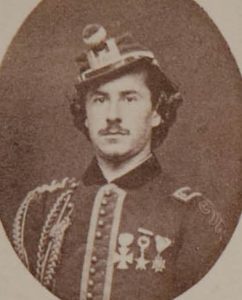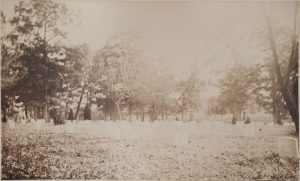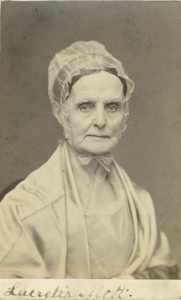By Susan Martin, Senior Processing Archivist
This is the fourth installment in a series on the diary of William Logan Rodman at the Massachusetts Historical Society. Click here to read Part I, Part II, and Part III.
In May 1861, after the attack on Fort Sumter and the outbreak of the Civil War, William Logan Rodman of New Bedford, Mass. volunteered for the Home and Coast Guard. The Home and Coast Guard, a home-front military corps raised for coastal defense, was garrisoned at Fort Phoenix at the mouth of the Acushnet River. Rodman participated in drills and other training and seemed to enjoy it.
But his confidence took a serious hit with the Union loss at the First Battle of Bull Run on 21 July 1861. Rodman was chastened, but refused to despair, writing in his diary on 1 August: “I had not heart to write last week on the Bull’s Run defeat which still occupies my mind. […] We shall be less confident & boastful but not less determined.”
In mid-September, with the war escalating, Rodman wanted to take a more active part, so he traveled to Washington, D.C. in hopes of a commission. His description of the city in these early days of the war is fascinating. Of the trip down, he wrote, “It was exciting and strange to see all along the rail road pickets & other guards.” Unsurprisingly, D.C. was teeming with people: “What with the ever moving crowd of strangers I was as much bewildered as ever in my life.” But he was surprised at how safe it felt, considering Bull Run was only 30 miles away. And he was impressed and heartened on seeing “thousands of horses in pens near the Observatory grounds. Acres of horses. Acres of waggons and ambulances. Acres of Hay & other stores.”
While in the capital, Rodman took the opportunity to play tourist. On 22 September, he watched a reconnaissance flight of the newly formed Union Army Balloon Corps conducted by Chief Aeronaut Thaddeus Lowe. The following day, Rodman went to see the notorious Marshall House inn in Alexandria, Va., which he found closed. It was there that Col. Elmer E. Ellsworth, just four months before, had been killed by the inn’s proprietor for removing a Confederate flag from the building. The proprietor, James W. Jackson, was also killed. Rodman called it “a forlorn looking place to be so famous.”

Rodman also visited Arlington House, the former home of Gen. Robert E. Lee, “a shabby old mansion surrounded by magnificent trees and commanding a superb view.” This estate is now the site of Arlington National Cemetery.

Finally, on 25 September 1861, Rodman saw the sight he’d most wanted to see: Abraham Lincoln in the flesh. Rodman was in the office of Gen. George W. Cullum, aide-de-camp to Gen. Winfield Scott, when in walked the president himself. Rodman’s description of Lincoln is one for the ages:
While at the latter’s office saw the President who came in to see Gen Scott. Long, lank & round shouldered with tumbled shirt & cravat no waistcoat and a $1.25 brown linen coat Old Abe is no beauty. Looks like a New England stationary pedlar or book agent. He’s a man tho and doing his work well so far. Never mind his garb his heart & head are right.
On his way home from D.C., Rodman stopped for a few days in the Germantown area of Philadelphia, where many members of his sprawling family lived. These included his uncle William Logan Fisher, his cousin Sarah (Fisher) Wister, and her husband William Wister.
Germantown had long been home to many Quaker and Mennonite families and therefore a hotbed of anti-slavery sentiment. Rodman’s family on both sides were Quakers, and this branch were Hicksites, the more “radical” branch of the Society of Friends. Rodman didn’t write much in his diary about his own religious beliefs, but they seemed to align with his Germantown relatives. On 29 September, he attended a Hicksite Friends meeting, where he was lucky enough to hear a “capital sermon” by the remarkable abolitionist, suffragist, and reformer Lucretia Mott.

Rodman’s trip had been unsuccessful—he didn’t get a commission. That wouldn’t come until almost a year later. But in the meantime, he was elected to serve as a representative to the Massachusetts legislature, and his patriotic zeal was undiminished. After the Union victory at Port Royal and the occupation of Beaufort, S.C., he wrote:
I think there is a very general feeling that it would be nothing more than justice to utterly destroy Charleston and block up its harbor forever as a monument of our detestation of this vile rebellion. The Negro question is to be presented to us in strong relief now. Beaufort District possess out of a population of 38000, 32000 Slaves. What shall be done with them?
What was “done with them” was what became known as the Port Royal Experiment, an attempt to “create schools and hospitals” for formerly enslaved people “and to allow them to buy and run plantations.” It was, in the words of historian Willie Lee Rose, a “rehearsal for Reconstruction.”
Join me here at the Beehive for the conclusion of William Logan Rodman’s story.

